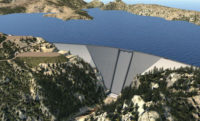A wildfire, driven by wind gusts up to 105 mph, swept through 6,000 acres in suburban neighborhoods east of Boulder, Colo., on Dec. 30, destroying 1,084 homes and damaging 149 others in the towns of Superior and Louisville, according to estimates from the Boulder County sheriff’s office.
One person has been found dead in the ruins of his home and another is still missing and may have been killed in the blaze, despite early reports of no fatalities, public safety officials said. At least six people suffered minor injuries, mostly from flying debris. The inferno forced thousands of people in the area from their homes. It took hours for many to flee their neighborhoods over roads choked with traffic and debris.
The blaze, dubbed the Marshall fire because of its proximity to the nearby community of Marshall, leveled entire neighborhoods in what officials during an early press briefing called a “mosaic pattern” that left some homes intact while others adjacent or nearby burned to the ground.
Early damage estimates total over $500 million, which would make the fire the most destructive in state history in terms of property loss. County officials said that with about 1,778 homes in the burn area, it will take some time to fully assess the damage.
Investigators at the scene said it was too soon to assign a cause for the fire, but early speculation that pointed to sparks from downed power lines due to the high winds was downplayed when Xcel Energy reported on New Year's Eve that all of its lines were still intact. A search warrant was issued for a property in the southeastern part of Boulder County, where there were reports of a shed on fire. The county had issued a ban on all outdoor fires because of a high-wind warning that day.
Also, officials said that a prairie landscape parched by drought helped to fuel the fire's rapid progress. Until a snowstorm moved into the area on Dec. 31, there had been almost no precipitation for months.
Only Minutes to Evacuate
The blaze may have begun as a small yard fire that was spotted before noon on Dec. 30 in south Boulder and quickly became a wind-driven inferno whose speed and ferocity caught thousands of people by surprise. Most had only a few minutes to gather what they could and leave after sheriff's deputies showed up at their door with evacuation orders.
Hundreds of firefighters from across the Denver-Boulder metro area were called in but could do little to stop flames or even slow them down. Xcel Energy reported more than 29,000 customers across Colorado had lost power as of 6:30 p.m. on Dec. 31.
The blaze also forced a full evacuation of the 114-bed Avista Adventist Hospital in Louisville, near U.S. 36, with patients shuttled to nearby medical facilities. Officials said in a news release that the hospital did not have "direct fire damage" but will "remain closed for the foreseeable future."
A hotel in Superior burned to the ground, and the flames damaged or destroyed several retail outlets in the area. The smoke plume stretched for hundreds of miles and was visible on weather radar throughout the day.
Colorado Gov. Jared Polis declared a state of emergency on Dec. 30, and President Joe Biden approved federal emergency funds the following day to help stranded residents, many of whom spent the night at area rec centers and churches.
Some residents were allowed to return to their neighborhoods on Jan. 1 despite ongoing hot spots and debris-clogged roads. Others are still waiting to get into the affected areas. The towns of Superior and Louisville have been placed on boil-water alerts.
Possible flare-ups were quelled by nearly a foot of snow that fell in the Boulder foothills on Dec. 31.
This story was updated Jan. 7 to include information about the fatality and the number of homes lost in the fire.




Post a comment to this article
Report Abusive Comment